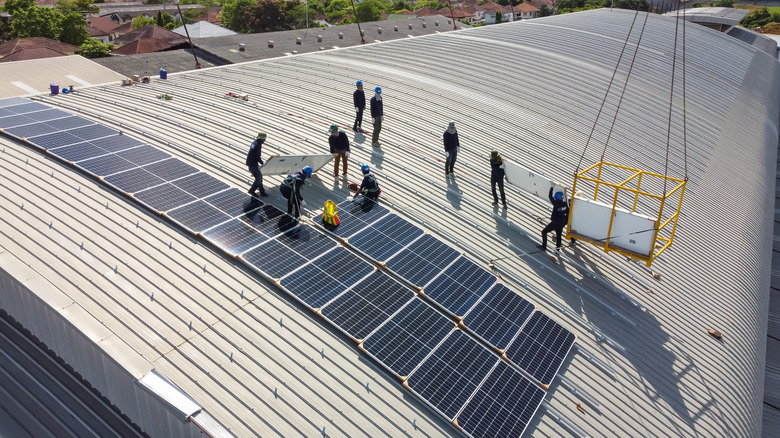McDonald's Plans To Go Solar At Hundreds Of Locations
In 2020, McDonald's opened a restaurant in Walt Disney World that was 100% powered by solar energy, reports Fast Company. A combination of solar panels installed on the roof and solar glass windows around the building generated enough energy to keep the entire kitchen and dining room running. At the time, Carol Ross Barney, head of the architecture firm that designed the building, said this project would serve as an experiment for McDonald's to test how far it could make solar power work for its operations. Indeed, the transition hasn't come without challenges.
As SolarCompanies.com explains, fast food restaurants require more energy than gas stations and retail stores. Industrial freezers, grills, fryers, ordering kiosks, and air conditioning take up a lot of power — and, for compact fast food restaurants, finding space to put all those solar panels can be a challenge. Some fast food stores are even further limited by their geographic locations. Particularly in major cities, many restaurants exist on the first floor of a skyscraper. Multiple floors of apartments and offices stacked on top of a ground-floor McDonald's means a solar panel up on the roof isn't a practical placement.
Fast Company reported that by 2030, McDonald's emissions would have to be 36% lower than they were in 2015 to stay on target for the goals it had in 2020. In October 2021, McDonald's announced its goal of becoming totally emissions-neutral by 2050. Recently, the company revealed the latest development in its environmental journey: Hundreds of locations are going solar.
A huge development in renewable energy
Per Nation's Restaurant News, McDonald's inked a deal with its North American Logistics Council to use renewable energy for supply chain buildings. The solar power will be provided by Enel North America's Blue Jay renewable energy project based in Grimes County, Texas. By 2023, Blue Jay says it plans to power McDonald's entire lineup of supply chains, distribution centers, and warehouses.
This initial purchase will gain McDonald's roughly 470,000 megawatt hours of solar energy per year. If that sounds like a lot, it's because it is. Back in 2009, Chipotle Mexican Grill installed solar panels on 75 Chipotle restaurants nationwide in collaboration with Houston-based company Standard Renewable Energy. In total, these panels were estimated to produce 500 kilowatt hours of electricity, reducing carbon dioxide emissions by 41 million pounds, says Hospitality Technology.
Chipotle's figures might have been impressive for 2009, and perhaps they even helped pave the way in the solar energy fast food frontier. But, McDonald's latest 470,000-megawatt hours of solar energy is enough energy to fully power 900 McDonald's stores, cutting 170,000 tons of carbon dioxide emissions. The move is crucial, and it seems like McDonald's has been planning it for a while.

